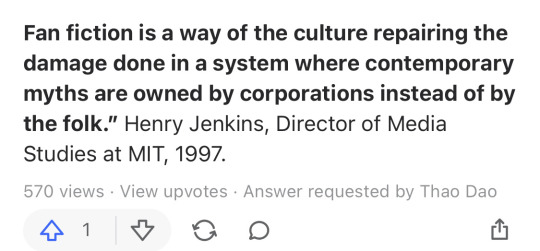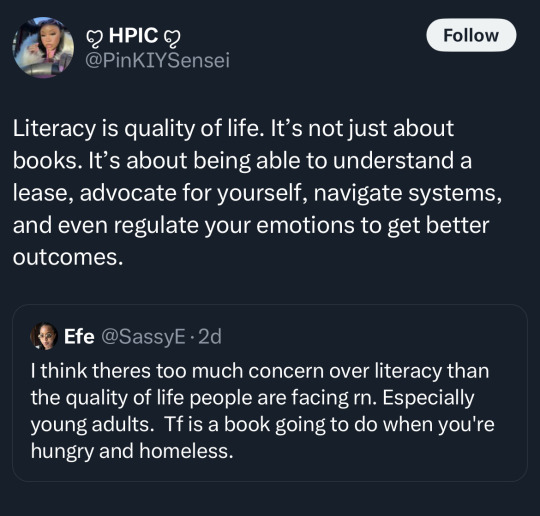Don't wanna be here? Send us removal request.
Text
Everyone is so weird about people who cry easily. Fellas, is it evil and manipulative to *checks notes* have an involuntary stress response?
118K notes
·
View notes
Text

March 2019: Maiko Fukutomo (Horiyae Okiya) and Maiko Chikaharu (Komaya Okiya) of Miyagawacho setting two paper boats afloat on the river during Hina Nagashi at the Shimogamo Shrine.
Source: helvetica on Instagram
312 notes
·
View notes
Text
Good addition to the list of words here
21K notes
·
View notes
Text

Upside to stop and go traffic- I could get a picture of these absolutely iconic bumper stickers.
25K notes
·
View notes
Text
I was meeting a client at a famous museum’s lounge for lunch (fancy, I know) and had an hour to kill afterwards so I joined the first random docent tour I could find. The woman who took us around was a great-grandmother from the Bronx “back when that was nothing to brag about” and she was doing a talk on alternative mediums within art.
What I thought that meant: telling us about unique sculpture materials and paint mixtures.
What that actually meant: an 84yo woman gingerly holding a beautifully beaded and embroidered dress (apparently from Ukraine and at least 200 years old) and, with tears in her eyes, showing how each individual thread was spun by hand and weaved into place on a cottage floor loom, with bright blue silk embroidery thread and hand-blown beads intricately piercing the work of other labor for days upon days, as the labor of a dozen talented people came together to make something so beautiful for a village girl’s wedding day.
What it also meant: in 1948, a young girl lived in a cramped tenement-like third floor apartment in Manhattan, with a father who had just joined them after not having been allowed to escape through Poland with his pregnant wife nine years earlier. She sits in her father’s lap and watches with wide, quiet eyes as her mother’s deft hands fly across fabric with bright blue silk thread (echoing hands from over a century years earlier). Thread that her mother had salvaged from white embroidery scraps at the tailor’s shop where she worked and spent the last few days carefully dying in the kitchen sink and drying on the roof.
The dress is in the traditional Hungarian fashion and is folded across her mother’s lap: her mother doesn’t had a pattern, but she doesn’t need one to make her daughter’s dress for the fifth grade dance. The dress would end up differing significantly from the pure white, petticoated first communion dresses worn by her daughter’s majority-Catholic classmates, but the young girl would love it all the more for its uniqueness and bright blue thread.
And now, that same young girl (and maybe also the villager from 19th century Ukraine) stands in front of us, trying not to clutch the old fabric too hard as her voice shakes with the emotion of all the love and humanity that is poured into the labor of art. The village girl and the girl in the Bronx were very different people: different centuries, different religions, different ages, and different continents. But the love in the stitches and beads on their dresses was the same. And she tells us that when we look at the labor of art, we don’t just see the work to create that piece - we see the labor of our own creations and the creations of others for us, and the value in something so seemingly frivolous.
But, maybe more importantly, she says that we only admire this piece in a museum because it happened to survive the love of the wearer and those who owned it afterwards, but there have been quite literally billions of small, quiet works of art in billions of small, quiet homes all over the world, for millennia. That your grandmother’s quilt is used as a picnic blanket just as Van Gogh’s works hung in his poor friends’ hallways. That your father’s hand-painted model plane sets are displayed in your parents’ livingroom as Grecian vases are displayed in museums. That your older sister’s engineering drawings in a steady, fine-lined hand are akin to Da Vinci’s scribbles of flying machines.
I don’t think there’s any dramatic conclusions to be drawn from these thoughts - they’ve been echoed by thousands of other people across the centuries. However, if you ever feel bad for spending all of your time sewing, knitting, drawing, building lego sets, or whatever else - especially if you feel like you have to somehow monetize or show off your work online to justify your labor - please know that there’s an 84yo museum docent in the Bronx who would cry simply at the thought of you spending so much effort to quietly create something that’s beautiful to you.
35K notes
·
View notes
Text
Fuck it, I didn't want to make a post on this but it's bugging the hell out of me so let's exorcize the thought.
Lilo and Stitch is an extremely good children's movie. I've been working at a daycare for over five years now, and out of all the children's movies I've shown to an auidence of twenty or so school-age kids (i.e. between the ages of 5 and 12), the only movie that's held their attention as well as Lilo and Stitch is The Emperor's New Groove, and the only one that's held it better is An American Tail. Of those three, Lilo and Stitch has won the vote of "what movie we will watch" the most. It not only entertains kids, but emotionally captivates them from start to finish, because it very thoroughly understands how to engage children on their level. It's a smart, tightly written children's movie.
The feat of story-telling genius it pulls of lies in its ability to reach both where children's imaginations want to go and where their lived real-world experiences lie - most children's movies focus on one or the other, but Lilo and Stitch dives deep into both. On the imagination side, there's Stitch's whole plotline of being a little alien monster being chased by other weirdo aliens onto earth because they want to stop him from running amok and causing havoc (which, of course, happens anyway in fun cartoony comedy/action spectacle). On the real-world side, you have Lilo's plotline of being a troubled little girl who has an abundance of very real problems that, like an actual child, she struggles to comprehend and deal with, as well as the many adults in her life that care about her to some degree but all struggle to fully understand her. Kids want to be Stitch and run amok and cause cartoony havoc. Kids, even the least-troubled kids, relate to Lilo, because all of them have been in a similar situation as her at least once in their lives.
Balancing these two very different stories, with very different tones and scopes to their respective conflicts, is a hard writing task, but Lilo and Stitch manages to do it in a way that seems effortless with one very powerful trick. The two plots are direct mirrors to each other, complete with the characters involved in each having foils in the respective plot. To break it down:
Stitch, the wild and destructive alien gremlin who everyone has labeled as a crime against existence, is Lilo, the troubled young girl who's viewed as a "problem child" by all the adults in her life. In both plotlines, Stitch and Lilo are facing the threat of being "taken away" from the life they know because they act out, and in both plotlines, we see that this is an unfathomably cruel thing to do to them and will not actually solve the problems they have.
Dr. Jumbaa, the mad scientist who made Stitch because making monsters is what mad scientists do, and who had no intentions of ever being nurturing or parental to anything or anyone in his life, is Nani, Lilo's older sister whose parents died when she was young and now is forced to act as a parental substitute despite not being mentally or emotionally prepared for that responsibility yet. Both Dr. Jumbaa and Nani are trying to get their respective wild children in line with what society wants them to be, and both are struggling hard with it because they in turn have a lot of growing to do before they can actually accomplish that.
Pleakley, the nebbish alien bureaucrat who ends up being assigned to help Dr. Jumbaa despite being mostly uninvolved in creating the whole Stitch situation, is David, the nice but mostly ineffectual guy who's crushing on Nani and wants to help her but doesn't really have much he can provide except emotional support. Ultimately Pleakley and David prove that said emotional support is a lot more helpful than it seems on the surface, as they give Jumbaa and Nani respectively a lot of the pushes they need to become better in their parental roles.
The Grand Councilwoman, who runs the society of aliens that is trying to banish Stitch forever for his crime of existing, is Cobra Bubbles, the Child Protective Services agent who is in charge of deciding whether or not Lilo needs to be taken away from her home forever for, ostensibly, her own good. Both are well-intentioned and stern, with a desire to follow the rules of society and do what procedure says is the most humane thing to do in this situation, but both lack the understanding of Stitch/Lilo's situation to actually help until the end of the movie.
Finally, we have Captain Gantu, the enforcer of the Galactic Council who is a mean, aggressive, sadistic brute but is viewed as a "good guy" by society because he plays by its rules (well, when he knows can't get away with breaking them, anyway), who is the counterpart of Myrtle, the mean, aggressive, sadistic schoolyard bully who is viewed as a "good kid" by other adults because she plays by the rules they established (well, when she knows she can't get away with breaking them, anyway). Both Gantu and Myrtle are, in truth, much nastier in temperament than Stitch and Lilo, but are better at hiding it in front of others and so get away with it, and often make Stitch and Lilo look worse in the eyes of others by provoking them to violence and then playing the victim about it - in fact, both even have the same line, "Does this look infected to you?", which they say after goading their respective wild-child victims into biting them.
The symmetry of these two plotlines allows them to actually feed into each other and build each other up instead of fighting each other for screentime. The fantastical nature of Stitch's plot adds whimsy to the far more realistic problems that Lilo faces so they don't get too heavy for the children in the audience, while the very real struggles of Lilo in her plotline bleed over into Stitch's plot and make both very emotionally poignant. When both plotlines hit their shared climax, they reach children on a emotional level few other movies can match - the terror of Lilo being taken away from her family, and the emotional complexity of that problem (Cobra Bubbles pointing to Lilo's ruined house and shouting at Nani, "IS THIS WHAT LILO NEEDS?" is so starkly real and heart-breaking), is matched and echoed in the visual splendor and mania of the spectacular no-way-this-is-going-to-work chase scene where Stitch, Nani, Jumbaa, and Pleakley all team up to rescue Lilo from Gantu.
The arcs of the characters all more or less line up. Nani confronts her own failures to be a guardian and parent to Lilo and resolves to do better and learn from her mistakes. Jumbaa, who through most of the movie protests to be evil and uncaring, nonetheless comes to not only care for Pleakley, but more importantly for Stitch too, and ends up assuming the role he never wanted but nonetheless forced himself into from the start: he is Stitch's family. Hell, the moment that reveals this is really clever - Stitch goes out into the wilderness to try and re-enact a scene from a storybook of The Ugly Duckling, hoping, in a very childish way, that his family will show up and love him. Jumbaa arrives and, coldly but not particularly cruelly, tells Stitch that he has no family - that Stitch wasn't born, but created in a lab by Jumbaa himself. But in that moment Jumbaa is proving himself wrong - because Stitch's creator, his parent, DID show up, and did exactly what happens in the story by telling Stitch the truth of what he is. It can't be a surprise, then, that later in the movie Jumbaa ends up deciding to side with Stitch, to help him save Lilo, and to stay on Earth with his child.
David and Pleakley go from being pushed away by Nani and Jumbaa respectively to essentially becoming their partners in the family. The Grand Councilwoman and Cobra Bubbles finally see how cruel their initial solution of isolating Stitch and Lilo from their family would be, and bend the rules they are supposed to enforce to protect and support this weird found family instead of breaking it apart. Gantu and Myrtle are recognized for the assholes they are and face comeuppance in the form of comedic slapstick pratfalls. And most importantly, Stitch and Lilo both get the emotional support and understanding they need to thrive and live happy lives as children should be allowed to do. It's like poetry, it rhymes.
It's a very precise, smartly written movie. It's a delicate balancing act of tone and emotions, with a very strong theme about the need for family and understanding that hits children in their hearts and imaginations. It's extremely well structured.
...
So it'd be kind of colossally fucking stupid to remake it and start fucking around with the core structure of it, chopping out pieces and completely altering others, with no real purpose beyond "Well, the executives thought it might be better if we did this."
36K notes
·
View notes
Text
i will never risk saying this in an actual gaming server but I don't think constantly screaming out of anger when you're playing is good
76K notes
·
View notes
Text
i tend not to take museum photos of things unless i think i can take a good one, and this was in a glass case so it had a lot of glare, but the sargent exhibit at the met has the only know photograph of madame x before he repainted the shoulder strap and seeing that for the first time in my life made me feel like my body was made of static
15K notes
·
View notes
Text
stop earning advanced degrees i need you to finish your fanfiction
64K notes
·
View notes
Text
crazy how every time a female character gets cliche misogynistic writing we have to explain to people again that fictional characters are not real and do not choose things for themselves.
45K notes
·
View notes
Text
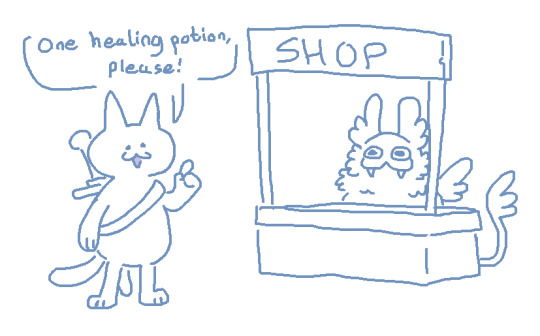
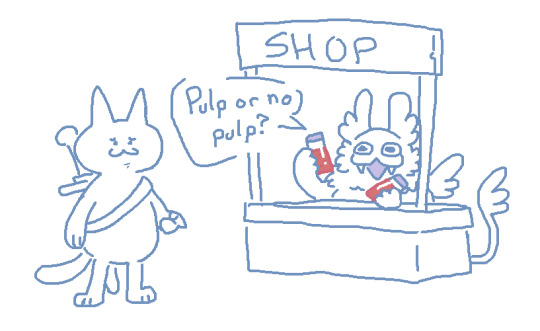
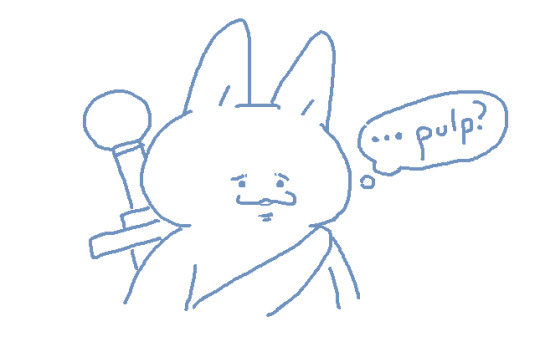
Do you prefer your potions with or without pulp?
111K notes
·
View notes
Text
It’s crazy that countries on the edge of the Sahara desert are reversing desertification by just digging half circles
48K notes
·
View notes
Note
Hi ave, it's me! mikael the weird dude. i just wanted to do an ask after realizing that i got into tumblr thanks to my friends sending your art yet never made any comments appreciating it. so first: your art style is like eating and celebrate a lot on a friend's wedding and waking up the next day feeling happy for their family (don't know if it's a good metaphor or not.). speaking of which: "what does every couple gifts eachother at their Wedding/dating Anniversary?" i got thinking about asking my favorite artists what their narilamb couples would give to eachother after a century of relashionship and got this as an opportunity to finaly say something to you! take care, sorry for any inconvenience (and gramatical mistakes). take care.
(aw thank you so much! i think its a sweet way to describe it n.n and thanks for the ask, it got me to think about how they might be after my lamb ascends, tall eldritch lamb<3)
Gifts for Lamb: GOLD (jewelry most of the time), blood sacrifices, songs, a dance.
Gifts for Narinder: blood sacrifices, catnip, blade weapons, camelias.


1K notes
·
View notes
Text
I understand the value of artistic liberties but what exactly is Yugio's haircut supposed to be. I've wondered this since childhood
#yugioh#reblogging for the last person's clear explanation#no shade but a lot of anime fans forget to look at japanese culture to make sense of things despite the creators being japanese
37K notes
·
View notes

